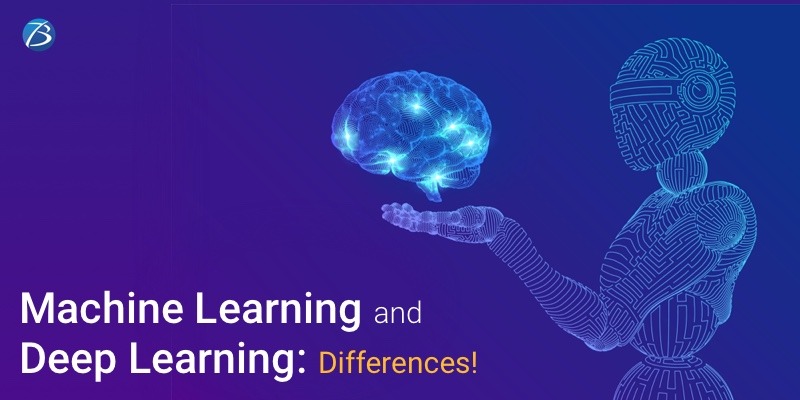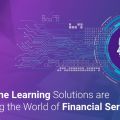What are the differences between Machine Learning and Deep Learning?

The technological marvel, Artificial Intelligence, has evolved significantly to give rise to two other ingenious technologies - Machine learning and Deep Learning. Both of these technologies have created a buzz in the software market and are setting new trends by executing unthinkable tasks. ML and DL are opening up new avenues for new-age entrepreneurs by making way for intelligent and intuitive software solutions. Entrepreneurs, these days, are roping in a Machine Learning Company for designing disruptive solutions for them.
Although Machine Learning and Deep Learning are subsets of the same technology – Artificial intelligence - they are quite different from each other. And, new-age businesses planning to leverage the technical benefits of these amazing technologies, must understand their differences well, so that they are able to implement these technologies correctly.
This post provides deep insights into Machine Learning and Deep Learning and explores their differences.
Machine Learning: An Overview
Machine Learning is a subset of Artificial Intelligence. It provides a system with the capacity to learn as well as improve from the experience gained, without the need for being programmed to that level. Data is employed for training and then finding the correct outcome. Machine Learning solutions perform a function using the data fed to it and progressively improve with time.
This technology is used for executing all types of automated tasks across several industrial domains right from data security companies for identifying malware to finance businesses who want to receive alerts for favorable trades.
Machine Learning is classified into 3 categories
Supervised Learning: This approach involves a wholly governed learning process, wherein the result is predicted based on a set of training samples provided with training labels also called the classifying data point. Here machine learning developers tell the algorithm what to predict during the training time, hence the name supervised learning.
Unsupervised Learning: This approach does not get training labels for the training samples. Here, the algorithms are created in such a manner that they are capable of finding suitable patterns and structures within the data provided. Similar data points are assembled together after the consistent patterns become apparent. Various data point appears in different clusters. It projects high-dimensional data into low-dimensional ones, for visualizing or analyzing.
Reinforced Learning: This approach involves a robot-like agent that performs actions and quantifies outcomes to learn how it should behave within a given environment. It follows the MDP (Markov Decision Process) – receives a reward point for making a correct response. This expedites the confidence level of the agent and encourages it to take up more such functions.
Example:
When ML is applied to an on-demand music streaming service, its task is to find out what new songs/artists to suggest to specific groups of listeners. For making decisions about such recommendations, an ML algorithm relates the user’s preferences with those of other users with similar musical tastes.
Deep Learning: An Overview
Deep learning, a subset of ML, is a technology where recurrent neural network and artificial neural network comes together. The formation of algorithms is quite similar to that of ML, only with the difference that there are more algorithms levels involved. All of these networks combine to form a layered structure of algorithms termed the artificial neural network – it’s just like the biological network of neurons present inside a human brain. Deep learning solutions continuously analyze data with a logical structure, just like the processing that happens inside a human brain to draw conclusions.
Deep Learning applications can solve complicated problems by processing the algorithms and is way more capable than the standard ML models.
Multiple layers that are stacked between the input and output layer
- Input layer consisting of a time series data or pixels of an image
- Hidden Layer called weights; it’s learned while the neural network is being trained
- The output layer is the final layer that provides a predictive analysis based on the input that has been fed into the network.
Example:
The Google-developed gaming app named AlphaGo is a perfect example of Deep Learning implementation. A computer program has been created using a neural network for playing this abstract board game against professional players. And, AlphaGo has successfully defeated world-famous players of the Go game – an instance of artificial intelligence defeating human intelligence.
Deep learning is also used for functions like translation, speech recognition, and operating self-driving cars.
Key Differences between Machine Learning and Deep Learning

Let’s now explore the key differences between Machine Learning and Deep Learning based on the following parameters.
Basic Functioning Principle
Machine learning is a super-set of Deep learning that takes in data as an input, then parses the data and makes decisions based on the learning while being trained. Deep learning, on the other hand, is a subset of ML, here data is accepted as an input for making intelligent and intuitive decisions using a layer-wise stacked artificial neural network.
Machine learning solutions are apt for solving problems that are simple or partly complex; whereas Deep Learning models are suitable for solving more complex problems.
The Type of Data involved and the Problem Solving Technique
Machine learning solutions usually deal with structured data and hence, employ traditional algorithms such as linear regression. Deep learning models can work with structured as well as unstructured data as they depend on the layers of an artificial neural network. Machine Learning algorithms parse data in parts and after processing these parts separately, integrate them to produce the final outcome. Contrarily, Deep learning systems follow an end-to-end approach - take in the input for a problem and produces the end-result directly.
For example, a program has to identify specific objects - license plates of cars parked in a lot - within an image; find out the objects’ identity and location. With an ML solution, this task will be executed in two steps – detecting the object and then recognizing it. Using a Deep Learning application, the task will be completed at one go – you input the image and the identified objects along with their location appear in a single result.
Data Dependencies and Output
Machine Learning handles thousands of data points and its outputs include numerical values or classifications. Deep learning, on the other hand, handles millions of data and its outputs range from numerical values to free-form elements like text and speech.
ML depends on a large amount of data, yet can function smoothly with a smaller amount of data as well. But this is not the case with deep learning models – they perform well only if humongous data is fed to them.
Algorithm Usage
ML employs different kinds of automated algorithms for parsing data and turns them into model functions for predicting future actions or making informed decisions based on the learning acquired from collected and processed data. Data analysts detect these algorithms for examining particular variables within sets of data.
Deep Learning structures the algorithms in layers to build an artificial neural network. With this approach, data passes through several processing layers for interpreting data features and relations. This neural network is capable of learning and then forming intelligent decisions on its own.
Hardware Requirement
ML programs are less likely to be complex as compared to deep learning algorithms. Machine learning programs need a CPU to process and so, can function on conventional computers or low-end machines without the need for high computing power. Deep learning algorithms, on the other hand, require way more powerful hardware as well as resources; because of the complex nature of the mathematical calculations involved and the need for processing a huge amount of data. They use hardware like GPUs or graphical processing units, and this increases the demand for power. GPUs possess high bandwidth memory and hide latency while transferring memory on account of thread parallelism.
Feature Extraction Methodology
The Deep learning mechanism is an ideal way of extracting meaningful functions out of raw data and is not dependant on hand-crafted features such as a histogram of gradients, binary patterns, etc. Moreover, the feature extraction methodology is hierarchical – features are learned layer-wise. As a result, it learns low-level features from the initial layers and as it goes up the hierarchy, more abstract data representation is learned.
However, ML is not a suitable option when there is a need to extract meaningful features from data. This is because, for good performance, it is highly dependent on hand-crafted features provided as input.
The degree of human intervention needed
ML needs continuous human intervention for obtaining the best results. Deep learning does involve a more complex set-up procedure, but once set up requires very less human intervention.
Execution Time involved
Machine Learning algorithms consume much lesser time for training the model, but testing the model is time-consuming. On the contrary, Deep learning applications take much lesser time to test the model but take a bit longer to train the model.
Industry Readiness
It’s easy to decode ML algorithms and it can interpret which parameters were picked and why those parameters were chosen. Deep learning algorithms, on the contrary, are simply a blackbox and are capable of outshining humans in regards to performance. Thus, ML solutions are better bait for industry application as compared to Deep learning solutions.
Final Verdict
Machine Learning and Deep Learning are here to stay. Both of these technologies possess a huge potential in transforming every industry vertical. Dangerous tasks such as working within harsh eco-systems, activities concerning space travel, etc. are expected to be replaced by ML and DL models in the near future. So it’s high time to be well versed with these outstanding technologies.
However, developing and implementing ML and DL solutions is no cakewalk and so, it’s advisable to hire experienced professionals for this purpose. For technical assistance in designing, deploying, and maintaining, ML/DL models, Biz4Solutions, a highly experienced and competent outsourcing software company in India, would be a good choice. We have extensive experience and expertise in dealing with ML and DL systems for global clients.
Other articles and publications:
Articles and publications of other companies:
- +1 (469) 277-0804
- 8305 Tripoli Trl, Frisco, TX 75034, United States
- www.biz4solutions.com/








